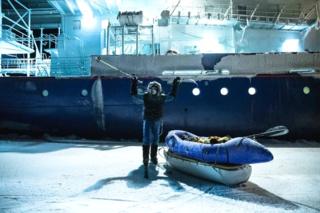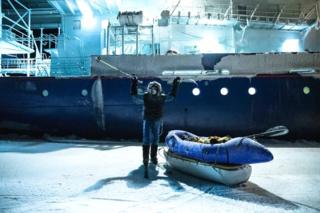Mike Horn and Boerge Ousland: North Pole explorers complete epic trek
The Norwegian-South African duo met up with a rescue team as they were dangerously low on food. …

 Image copyright AFP
Image copyright AFP Two explorers who trekked hundreds of miles at the North Pole and were running out of food have reached safety after an epic journey across the ice.
South African Mike Horn and Norwegian Boerge Ousland covered about 1,800km (1,120 miles) on treacherous drifting ice in the past couple of months.
Because of delays, they had been expected to run out of food by Friday.
However, they managed to meet up with two Norwegians sent to rescue them despite a local storm.
The latest Instagram update on Sunday showed a picture of the four men on their way to the Norwegian polar research ship, the Lance, which was due to pick them up.
An earlier entry described how the two pairs had got closer and closer to each other until they spotted each other’s headlamps in the distance and began shouting “cries of joy”.
The men are now recuperating on the Lance, which will make its way out of the ice to the Pangaea, another ship which will collect them to bring them back to Svalbard, a Norwegian Arctic archipelago.
The Norwegian pair – Bengt Rotmo and Aleksander Gamme – set off on Tuesday, carrying food for the Horn-Ousland team.
Expedition organiser Lars Ebbesen, who was maintaining contact with both teams via satellite phone, told the BBC on Friday that the Horn-Ousland team did not want to be rescued by helicopter, but that they agreed to meet up with the Norwegian pair.
At that point, the wind was building up and they had little food. If they had got trapped, they would not have had enough food to last.
The pair set off on 23 September and should have completed their trek in mid-November. They spent weeks alone on the ice in the dark – in the Arctic winter, there is no daylight.
The pair faced many obstacles, including fluctuating temperatures on the ice – from -40C to +2C (35F), a sign of climate change, according to Horn.
Sometimes at night, when they were camping, the drifting ice moved them backwards, adding to the distance they had to cover. Thinner polar ice than normal also added to the risks and slowed them down.
At one point, Horn fell into the icy water resulting in frostbite to his hands and nose. The pair had lost a lot of weight, and were feeling weak and tired by the end of the journey, he said.
Read more on related topics:
A key aim of the expedition was to collect data on the Arctic ice melt, which scientists attribute to global warming.
The journey began on the Alaskan side of the North Pole and was due to end in Svalbard.
Mike Horn, 53, became famous after completing a solo journey around the equator without motorised transport in 1999-2000.
In 2004, he completed a two-year solo circumnavigation of the Arctic Circle, and in 2006, along with Borge Ousland, became the first man to travel without dog or motorised transport to the North Pole during winter, in permanent darkness, according to his website.


